Sciencepic of the day: Virus Induced Gene Silencing
What's up with these white albino plants?!?

The Image: Plants that feature low levels of Phytoene Desaturase (PDS) gene expression. Plants on the fringes of this image are empty vector controls (wildtype virus) and look normal. Source: My own collection.
Good question. The answer is; they are experiencing VIGS! Now you probably want to know what VIGS is!
Virus induced gene silencing is exactly what these words describe. It is the silencing of genes that is induced by the presence of a virus. Let me explain below.
Besides fancy pathways that lead to cell death, plants have evolved other means by which they can resist pathogens. One of these alternative mechanisms is the targeting and suppression of viral RNA accumulation. There are many viruses that can infect and propagate on plants. Some of these viruses have RNA genomes rather then DNA-encoded genomes (which is what we have). When these RNA viruses enter plant cells, they multiply by getting the plant cell to produce the required proteins while also replicating the viral genomes. This allows movement of the virus and its rapid accumulation.
When viruses hijack the host cell machinery, it comes at an enormous cost to the plant as it has to make loads of proteins and RNA molecules it really does not need. To counter RNA viruses, plants have therefore adopted an RNA based and sequence-specific process to suppress the accumulation of viral RNAs. It does this by chopping up the viral RNA and using the degraded small RNA molecules to target more of the same viral RNAs. Thus, the defense is induced by the virus and is targeted against the viral genome sequence.
The question is: what would happen if a piece of host mRNA ended up in a viral RNA molecule? The answer is: it would target it too!!
This has led researchers to adopt a functional tool where they
(1) clone a gene fragment into the genome of an RNA virus
(2) Inoculate plants with this virus (in this case Nicotiana benthamiana)
(3) wait for the silencing signal to start reduce viral RNA accumulation (this takes between 2-3 weeks)
(4) assess whether the levels of mRNAs for the endogenous gene in question (corresponding to the fragment cloned into the viral genome), is reduced (silenced).
The image shown is that of the Pds gene (A phytoene desaturase) which is a key enzyme in pigment biosynthesis. when it is not present, chlorophyll will bleach and leaves will turn white. It is a control that we often use to see whether our silencing experiment is working. Enjoy this pic and my other post.
I will be taking a short break. C ya on monday!
I hope you will find these pieces interesting. Your vote and follow help me open up the exciting world of plant biology and pathology to you.
Thank you @foundation for this fantastic SteemSTEM gif

Congratulations @huitemae! You have completed some achievement on Steemit and have been rewarded with new badge(s) :
Click on any badge to view your own Board of Honor on SteemitBoard.
For more information about SteemitBoard, click here
If you no longer want to receive notifications, reply to this comment with the word
STOP